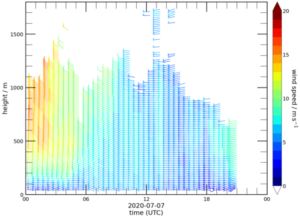 Scientists would not live up to their creative spirit, if they could not find a solution for a measurement campaign in the time of social distancing and limited travel opportunities. For summer 2020, we had planned the international field experiment FESSTVaL (http:// fesstval.de/) for detecting wind gusts and measuring cold air outflows from deep convective clouds at the observatory of the German Weather Service in Lindenberg. Our full campaign FESSTVaL, short for Field Experiment on Submesoscale Spatio- Temporal Variability, had to be re-scheduled for summer 2021 due to the pandemic. Nevertheless we did not give up our measurements this summer. In the currently ongoing campaign FESST@home, we nevertheless carry out our wind measurements in Lindenberg, but, for most of the team, the work is done from home. Our FESST@home team at the University of Cologne is interested in the observations of wind gusts and nocturnal low-level jets — wind speed maxima that develop in a few hundred meters above the ground at night. To this end, we use the measurement data from remote sensing instruments installed and operated by our partners in Lindenberg, which we can investigate via the internet in our home offices. We aim to assess and help to improve the representation of these wind characteristics in the high-resolution reanalysis products used for climate monitoring and diagnostics. We develop these regional high- resolution re-analyses in the HErZ branch (https://www.herz.uni-bonn.de/wordpress/) based at the University of Cologne and the University Bonn in close collaboration with our partners at the German Weather Service in Offenbach. This week, we closely work together despite being apart by exchanging our views and data interpretations in daily briefings in virtual meetings. Who would have thought that a joint field campaign is possible, despite all difficulties that the pandemic is causing.
Scientists would not live up to their creative spirit, if they could not find a solution for a measurement campaign in the time of social distancing and limited travel opportunities. For summer 2020, we had planned the international field experiment FESSTVaL (http:// fesstval.de/) for detecting wind gusts and measuring cold air outflows from deep convective clouds at the observatory of the German Weather Service in Lindenberg. Our full campaign FESSTVaL, short for Field Experiment on Submesoscale Spatio- Temporal Variability, had to be re-scheduled for summer 2021 due to the pandemic. Nevertheless we did not give up our measurements this summer. In the currently ongoing campaign FESST@home, we nevertheless carry out our wind measurements in Lindenberg, but, for most of the team, the work is done from home. Our FESST@home team at the University of Cologne is interested in the observations of wind gusts and nocturnal low-level jets — wind speed maxima that develop in a few hundred meters above the ground at night. To this end, we use the measurement data from remote sensing instruments installed and operated by our partners in Lindenberg, which we can investigate via the internet in our home offices. We aim to assess and help to improve the representation of these wind characteristics in the high-resolution reanalysis products used for climate monitoring and diagnostics. We develop these regional high- resolution re-analyses in the HErZ branch (https://www.herz.uni-bonn.de/wordpress/) based at the University of Cologne and the University Bonn in close collaboration with our partners at the German Weather Service in Offenbach. This week, we closely work together despite being apart by exchanging our views and data interpretations in daily briefings in virtual meetings. Who would have thought that a joint field campaign is possible, despite all difficulties that the pandemic is causing.
